  Newport News Nuclear BWXT Los Alamos Director of Training Mark Russell, rear, with the September graduating class of the Nuclear Waste Processing Operator Boot Camp.
LOS ALAMOS, N.M. – Twelve newly trained nuclear waste processing operators received their nuclear waste processor or handler certifications last week after completing a 16-week boot camp program offered by EM Los Alamos Field Office (EM-LA) legacy cleanup contractor Newport News Nuclear BWXT Los Alamos (N3B).
Each graduate received a full-time work assignment at N3B after passing a waste operator comprehensive exam.
Such operator positions are projected to be among the most in-demand professions across the EM complex in coming years, according to an analysis EM completed earlier this year in conjunction with the Energy Facility Contractors Group, which represents contractors at DOE sites. And N3B has said recruiting and retaining employees for critical positions such as waste handling and waste processing operators is a top priority for the cleanup contractor.
N3B conducts the Nuclear Waste Processing Operator (NWPO) Boot Camp in partnership with the University of New Mexico-Los Alamos (UNM-LA). Students earn 10 college credits for the program. The curriculum combines on-the-job training for waste remediation as part of the EM-LA legacy cleanup mission at the Los Alamos National Laboratory (LANL), and classroom instruction at UNM-LA led by N3B instructors who have been awarded letters of academic title as faculty members.
One of the new graduates is Steven Flores, originally from Pecos, New Mexico, near Santa Fe. After high school Flores moved to Albuquerque, New Mexico, to attend college and work at several production jobs. He decided to move back to Northern New Mexico and took advantage of the NWPO Boot Camp training. He’s a processing operator and initially will be shadowing an experienced technician working with hazardous materials.
“The boot camp was a great step for me,” said Flores. “There’s no better way to break into a good career in DOE remediation work.”
Boot camp participants receive a competitive wage and full benefits while they are in the program. N3B pays tuition for boot camp participants and for boot camp graduates who pursue an associate degree in nuclear enterprise science and technology at UNM-LA.
“The NWPO Boot Camp program has been very successful,” said Paul Allen, dean of instruction at UNM-LA. “Many of these participants may not have seen themselves as prospective college students. But when they complete this certification, they see they can manage college coursework, and that provides them with an incentive to continue their education.”
This was the fourth NWPO Boot Camp session. Forty students have graduated from the program over the past four years.
N3B also offers a Radiological Control Technician (RCT) Boot Camp through a similar arrangement with UNM-LA. The RCT Boot Camp has been offered twice with a total of 30 graduates.
Elias Salazar, originally from Española, New Mexico, was a member of the first NWPO Boot Camp class in 2020 and he also earned his RCT certification earlier this year. Salazar is now an RCT-2 on the N3B Environmental Remediation team.
He recalls that the NWPO Boot Camp instructors created a clear path in the training.
“We knew what we had to learn, and they walked us through it one step at a time, so we were fully qualified at the end,” Salazar said. “Both boot camps set me up for a lot of success.”
N3B Operations Manager James O’Grady said, “The NWPO and RCT boot camp programs are critical in helping us train and retain the staff we need to support our work under the Los Alamos Legacy Cleanup Contract for EM-LA. I’m confident the boot camps and the experience these graduates gain as they work with us will serve as the foundation for successful careers long after we complete our mission here.”
-Contributor: Brian Leugs
 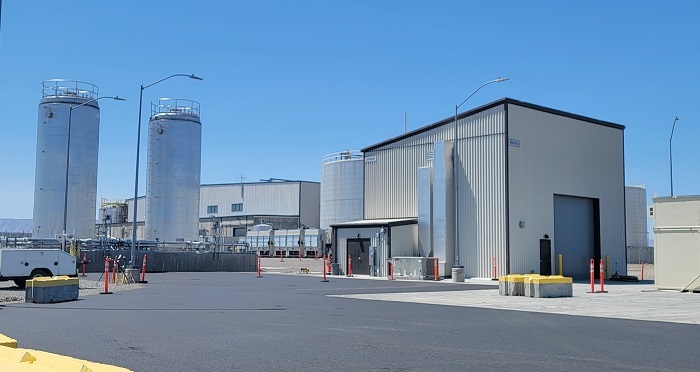 The Hanford Site’s Effluent Treatment Facility has been expanded to handle almost 7 million more gallons of wastewater per year when Hanford’s Waste Treatment and Immobilization Plant begins treating waste from large underground tanks.
RICHLAND, Wash. – Construction is complete on more than 40 upgrades that will increase the capability, efficiency and reliability of the Hanford Site’s Effluent Treatment Facility (ETF). The upgrades allow the facility to process liquid waste streams from the Waste Treatment and Immobilization Plant (WTP) and other facilities during tank waste treatment operations.
Managed by EM Office of River Protection (ORP) tank operations contractor Washington River Protection Solutions (WRPS), ETF is part of Hanford’s Direct-Feed Low-Activity Waste (DFLAW) Program to vitrify tank waste, immobilizing it in glass for safe onsite disposal.
“The ETF is the last step in the DFLAW process, and these upgrades prepare it for playing a key role in treating and disposing of contaminated wastewater from the vitrification process,” said Bibek Tamang, EM’s ETF program manager. “These upgrades were needed to prepare the ETF for 24/7 waste treatment operations.”
Upgrades to the nearly 30-year-old facility began in 2019. They include replacing monitoring and control systems, freeze protection systems and wastewater filtration systems, as well as the installation of a system to remove and safely dispose of hazardous byproducts of vitrification. Workers also constructed equipment to provide cooling water for the new system, and expanded a load-in station for more waste transfers from across the site.
In addition to preparing ETF to receive larger volumes of wastewater, WRPS expanded the capacity of the nearby Liquid Effluent Retention Facility (LERF) by adding a fourth 7.8 million-gallon storage basin to receive and store wastewater prior to treatment at ETF.
ETF’s upgrades were needed to handle the increased volume of wastewater that will be generated by the start of DFLAW operations. When fully operational, WTP is expected to transfer as much as 5.4 million gallons of effluent per year to ETF for processing, while Hanford’s Integrated Disposal Facility will add another 1.2 million gallons annually.
“ETF’s role in reducing tank waste volume is integral to the overall Hanford Tank Farms mission, since tank waste storage space is limited,” said Adam Mathews, ETF and LERF manager for WRPS. “The facility will become even more essential as the DFLAW process comes online.”
WRPS is testing the new systems in preparation for upcoming tank waste treatment activities to ensure ETF is ready to carry out its mission when 24/7 DFLAW operations begin.
-Contributor: Joan Lucas
 
OAK RIDGE, Tenn. – EM crews have removed more than 1 million gallons of water from the basement of the Beta-1 building at the Y-12 National Security Complex at Oak Ridge.
Oak Ridge Office of Environmental Management (OREM) cleanup contractor UCOR is ridding the building’s basement of water as it prepares the Manhattan Project-era building for eventual demolition.
In previous years, sump pumps failed, causing groundwater to fill the basement.
Workers removed this significant volume of water in 42 working days. Approximately 450,000 additional gallons of water will need to be pumped from the basement as cleanup progresses.
“The conditions in Beta-1 are a prime example of the type of circumstances crews are facing as they prepare aging, deteriorated structures for demolition at the site,” said Brian Henry, Y-12 portfolio federal project director for OREM. “We have numerous projects like this one ramping up at Y-12 that will be changing the landscape in the years ahead.”
 A worker lowers a hose to pump water from the basement area of the Beta-1 facility. Crews have pumped 1 million gallons over the past 42 work days, and they expect to pump another 450,000 gallons to finish the job.
The Beta-1 building was constructed in 1944 to enrich uranium during World War II. It was later converted to laboratory space for fusion-energy technology.
Demolition of the massive structure will eliminate old, unused infrastructure and open land to support future DOE missions.
To complete the work safely, UCOR built a water treatment skid outside the facility. The skid uses micron bag filters and carbon vessels to filter the water to meet stringent water quality standards. After treatment, the water is discharged.
Deactivation of the building will continue in the above-grade areas before progressing into the basement areas when they’re pumped dry.
“Our team has been working diligently to make sure we can safely move deactivation activities to the basement area, which has been problematic because of the water infiltration,” said Billy Lloyd, UCOR project manager. “Demolition of the building, expected to begin in 2026, will not proceed until we are certain we have successfully completed deactivation of the entire facility and have removed any obstacles or hazards to safely bring down the building.”
Crews are expected to complete pumping all of the water out of the basement this month.
-Contributor: Carol Hendrycks
 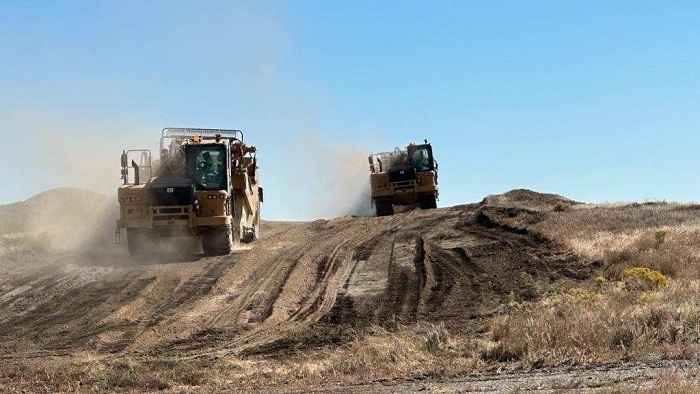 EM crews recently broke ground on a new cell for the Idaho Comprehensive Environmental Response, Compensation and Liability Act Disposal Facility, EM’s onsite, engineered landfill for cleanup program waste. The expansion will extend the landfill’s mission by about 25 years.
IDAHO FALLS, Idaho – EM crews have broken ground on a new cell of the largest active landfill at the Idaho National Laboratory (INL) Site, an expansion that will extend the life of the facility by 25 years and increase its capacity threefold.
For the last 20 years, the Idaho Comprehensive Environmental Response, Compensation and Liability Act (CERCLA) Disposal Facility (ICDF) has accommodated waste generated from CERCLA and demolition and dismantlement (D&D) remediation efforts at the INL Site.
“ICDF is a significant part of responsible waste management at the INL Site,” said Craig Reese, the ICDF expansion project manager for Idaho Environmental Coalition (IEC), EM’s cleanup contractor for the INL Site. “Looking forward, this project will continue that legacy and provide a cost-effective answer to meet our cleanup and environmental goals.”
 The Idaho Comprehensive Environmental Response, Compensation and Liability Act Disposal Facility is located near the Idaho Nuclear Technology and Engineering Center at the Idaho National Laboratory Site.
With a current capacity to dispose of 390,000 cubic meters of waste and debris — comparable in size to 10 football fields — the facility consolidates waste from cleanup sites into a single, controlled and environmentally compliant landfill, providing the INL with a cost-effective solution to its disposal needs. Once completed, the expansion project will increase disposal capacity to 1,060,000 cubic meters.
The ICDF is more than 80% full, and current projections show its existing infrastructure is inadequate to meet future demands created by onsite CERCLA cleanup activities and demolition efforts. A 2020 survey estimated that at least 340,000 cubic meters of onsite waste will likely be generated from CERCLA and D&D remediation efforts through 2050.
The result of the CERCLA regulatory process, the ICDF has stringent waste acceptance criteria. It only accepts waste generated from CERCLA and D&D remediation efforts. It does not accept offsite waste.
The new disposal cell has been designed like the existing landfill, with multiple liners, multiple leachate collection and detection systems, and lined evaporation ponds, all of which are compliant with state-of-the-art disposal facility requirements.
The new cell is projected to start accepting waste in 2026.
-Contributor: Carter Harrison
 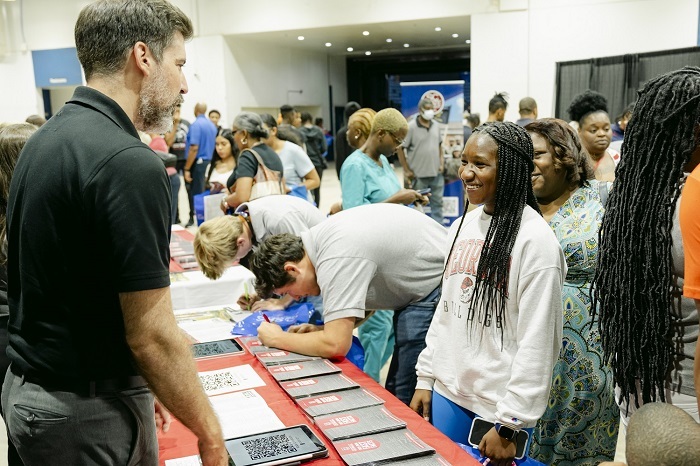 A local student connects with representatives with University of Georgia undergraduate admissions during the Savannah River Site’s Central Savannah River Area College Night at James Brown Arena.
Over 3,200 attendees and $15,000 in scholarships awarded during Savannah River Site-sponsored event
AIKEN, S.C. – During the recent Central Savannah River Area (CSRA) College Night, thousands of students filled the James Brown Arena in search of higher education opportunities, apprenticeships and future career paths at the Savannah River Site (SRS) and beyond.
Fifteen local high school seniors won scholarships totaling $15,000 during the event, sponsored by SRS.
“We are filling a huge need in our community,” said Cindy Hewitt, Education Outreach specialist with Savannah River Nuclear Solutions (SRNS), the SRS management and operations contractor. “CSRA College Night highlights many different careers and opportunities for students. This enables us to connect with the future workforce, spark interest in our most needed occupations and prove to students that they can make their dreams a reality.”
 Alleluia Community School senior Halle Janik accepts a $1,000 scholarship presented by Francine Burroughs, senior vice president, Savannah River Nuclear Solutions Workforce Services and Talent Management, at this year’s Central Savannah River Area College Night.
Nearly 3,250 attendees connected with 116 colleges and universities, four branches of military and many local technical colleges at the CSRA College Night.
Serving area students for three decades, the annual event has awarded more than $300,000 in scholarships and reached tens of thousands of participants over the years.
“There is something here for everyone,” said Lukas Willard, a senior at Aiken Scholars Academy. “Trying to navigate admissions and opportunities online can be very difficult. Here, you can ask direct questions to representatives from different colleges, military entities and potential employers from SRS. I was surprised to see so much exposure and opportunity under one roof.”
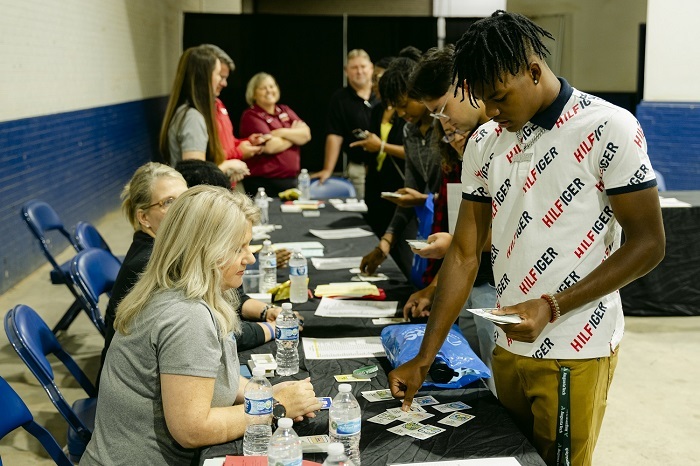 Over 30 volunteers from the Aiken County Public School District helped students find career matches through a career exploration activity.
Students and parents obtained information on scholarship and educational opportunities, and college admission requirements. They also participated in seminars on scholarships, learned about SRS apprenticeships and met with counseling centers.
Caitlin Norton, associate director of regional recruitment, represented the University of Alabama at Birmingham at one of the largest college recruitment events in Georgia and South Carolina.
“This was a fantastic way to get access to thousands of students who may be undecided or looking for their next big step,” said Norton. “With over 4,000 institutions in the country, this in-person event was a great way for a student to narrow down their options and find the perfect school without having to spend thousands on traveling or college visits.”
South Aiken High School senior Ariya Evans attended the career fair to gain better insight on her favorite universities.
“The career exploration activity further confirmed that the career path I’m pursuing aligns with my personality traits,” said Evans. “I was able to connect with representatives from some of my top schools to better understand the athletic training degrees offered. I’m 100% confident in my next steps after attending this event.”
Click here for additional information on CSRA College Night and SRS Education Outreach Programs.
-Contributor: Mackenzie McNabb
 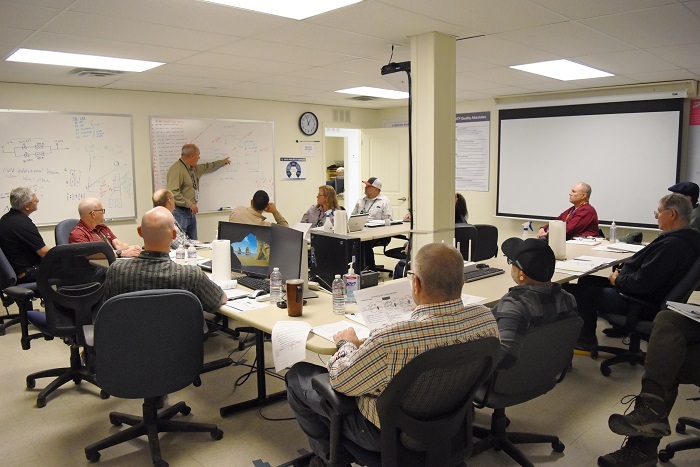
RICHLAND, Wash. – Teams with the Hanford Site's Waste Treatment and Immobilization Plant (WTP) are running through the detailed process workers will use to add simulated waste to a large melter in the next few months. The step is called cold commissioning because the simulated waste is not radioactive, and it allows workers to operate the plant and immobilize the simulated waste in glass without the hazards of real waste. The simulated waste will be heated with glass-forming materials in the melters, and the molten mixture will then be poured into stainless steel containers and disposed of at an industrial and hazardous waste landfill in Arlington, Oregon. Workers at WTP continue to prepare for the next major steps in getting the two melters in the plant’s Low-Activity Waste Facility and the rest of the plant ready to start treating the radioactive and chemical waste from large underground tanks at Hanford.
 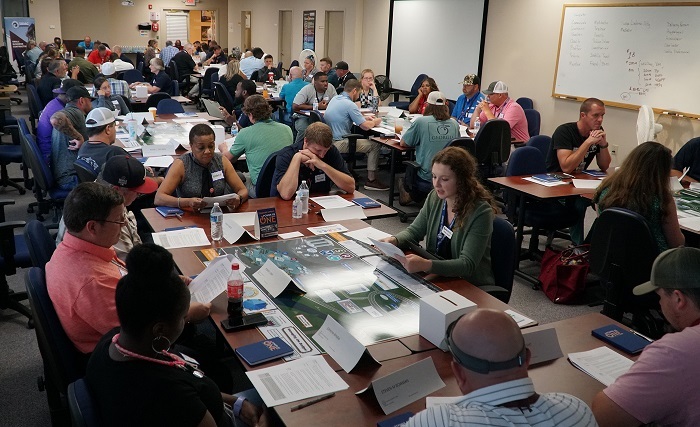 Savannah River Mission Completion (SRMC) employees participate in the first day of SRMC’s vision casting training initiative to learn about the company’s mission and vision.
AIKEN, S.C. – An EM contractor has completed a training series where employees dove deeper into the past, present and future of the Savannah River Site (SRS) liquid waste mission.
More than 3,000 employees with liquid waste contractor Savannah River Mission Completion (SRMC) participated in SRMC’s vision casting initiative. Led by a full-time SRMC employee serving as a group facilitator, each vision casting session was a small-group discussion that used informative scripts, a Liquid Waste Program vision board, fact cards and interactive activities to align all employees on what it will take to complete the SRS liquid waste mission.
SRMC’s mission is to safely reduce the risk of radioactive liquid waste stored at SRS in aging waste tanks to the community and the environment.
Bailey Arnett, SRMC waste disposal authority engineer, said helping to facilitate vision casting was a rewarding opportunity.
“I was able to meet numerous people in fields I don’t often interact with, hear stories from employees who have been at the site for longer than me and learn something new from every group,” Arnett said. “I think vision casting was important for our company because we were able to learn from one another, gain a new perspective and unite to accomplish future work as one team.”
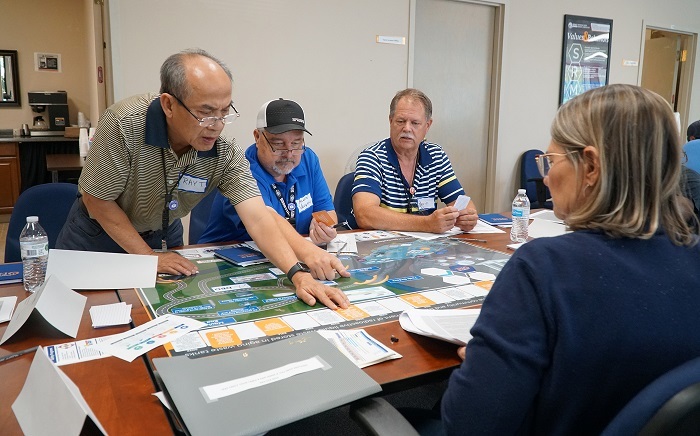 Ray Tran, an engineer for the Savannah River Site (SRS) tank farms, helps complete a timeline of SRS historical events as part of Savannah River Mission Completion’s vision casting training initiative.
According to SRMC President and Program Manager Dave Olson, this effort provided the opportunity for employees to learn more about SRMC, how every individual contributes and ultimately understand and appreciate the value they bring to the liquid waste mission.
“To complete our mission, SRMC will strive to perform risk reduction and operational optimizations while serving as the model of excellence in nuclear safety culture, workforce development and stakeholder engagement. Feedback from participants indicated that the vision casting effort was informative and beneficial,” Olson said. “Whether it was through new knowledge of how we operate, or a new connection made with a colleague, I believe everyone walked away with refreshed appreciation of their role as an SRMC team member — someone who is a part of one of the largest and most important cleanup missions in our country.”
SRMC is evaluating development of a computer-based training application so that new employees can also benefit from vision casting.
-Contributor: Colleen Hart
|